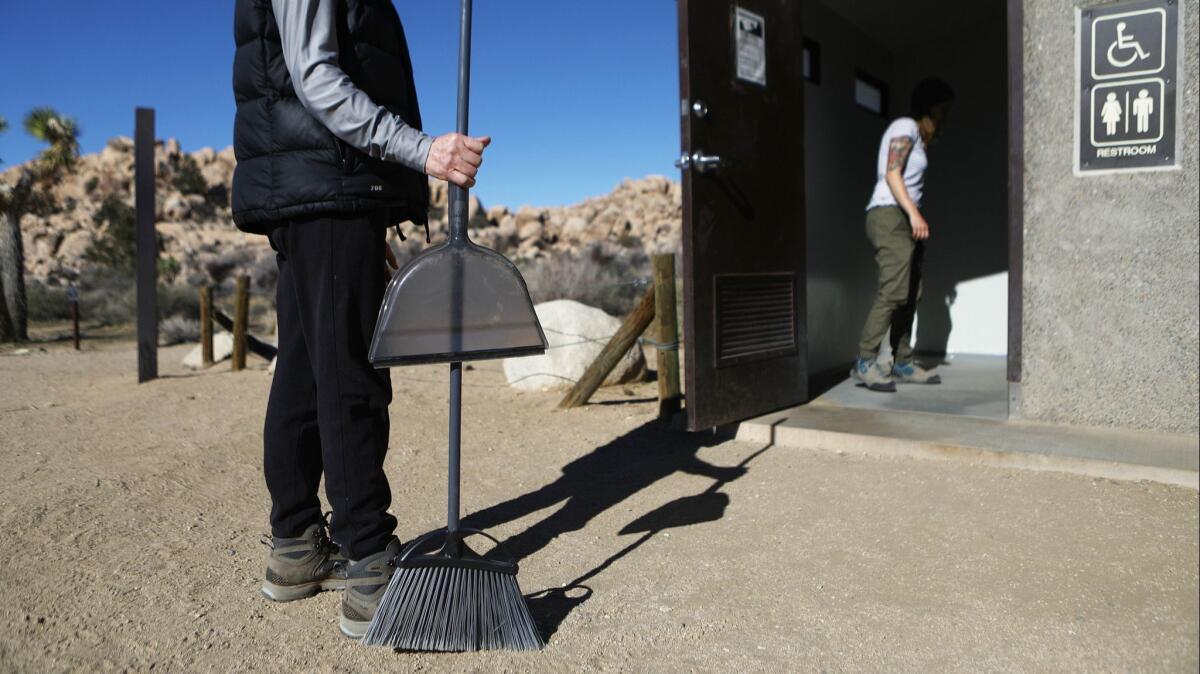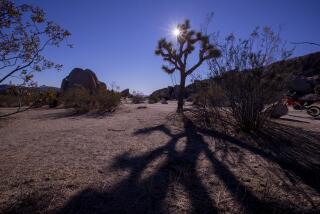From delicate soil to bears, government shutdown will cause lasting damage to national parks

When David Lamfrom drove into Joshua Tree National Park last week during the first days of the partial government shutdown, he was startled by the chaos.
He saw park visitors hiking off marked trails and driving their vehicles off paved roads, trampling and running over vegetation on the desert floor.
Lamfrom, the director of the California desert and national wildlife programs for the National Parks Conservation Assn., was concerned about the destruction of the delicate fungus, bacteria and rock that make up the so-called biological soil crust that plants rely on for growth.
âDeserts are really unique systems. Plant life is ancient there,â he said. âThe impacts being caused could take hundreds of years to recover from.â
As the shutdown of the federal government drags into a third week, worries about the long-term damage being done to the nationâs parks and disruptions to wildlife, including bears, are growing.
Diane Regas, chief executive of the Trust for Public Land, a nonprofit park advocacy organization, wrote a letter to President Trump on Thursday, calling for the immediate closure of every national park in the country for the duration of the shutdown to protect visitors and park resources.
âAllowing access to national parks without taking care to steward those resources is irresponsible and could result in irreversible damage and loss,â she wrote.
Unlike the government shutdown in 2013, the Trump administration has kept national parks open with limited staff in place. But, as bathrooms and other services have become overloaded, more and more campgrounds are closing at parks across California on a largely ad hoc basis.
The latest example is Death Valley National Park, where several campsites closed Friday because of health and safety concerns over human waste, trash, vandalism and damage to park resources, the parkâs chief of interpretation and education, Patrick Taylor, said in a news release.
Reports continue to trickle in from volunteers about champagne bottles left strewn about in Joshua Tree and human waste piling up on roads leading into Yosemite. In Texasâ Big Bend National Park, a hiker reportedly broke his leg and was carried out by fellow visitors.
âIt is a delicate balance between conservation and recreation,â said Steve Blumenshine, a professor of biology at Fresno State who spent time in Yosemite this week. âIn a shutdown, we take that to extremes.â
Regas said advocating for closing parks completely, rather than just campgrounds, is âa very unusual stanceâ for her organization, which works to increase access to parks and has donated land to expand them, including Yosemite National Park.
âBut we are not taking this lightly,â she said in an interview. âThis is urgent.â
Whether to shut an area of a park is up to each parkâs superintendent. He or she can bar visitors if resources âvulnerable to destruction, looting, or other damageâ cannot be adequately protected by the law enforcement officers who remain on duty during the shutdown, according to the National Park Serviceâs contingency plan for a lapse in federal funding.
Campgrounds at Joshua Tree closed at noon Wednesday, officials said, citing health and safety concerns over vault toilets that were near capacity. The waterless bathrooms, in which visitors can relieve themselves into a sealed container buried underground, had remained open. But no workers are around to pump out the waste.
Sequoia and Kings Canyon National Parks went a step further, closing entirely to visitors this week.
Meanwhile, an investigation into the Christmas Day death of a man at Yosemite is being delayed by the shutdown, National Park Service spokesman Andrew Munoz said Friday.
Yosemite officials received a 911 call reporting a man with a head injury in the Silver Apron area on the Merced River above Nevada Fall and rangers arrived in less than an hour, Munoz said. The man was removed from the water and received medical treatment, but he died from his injuries. He was not in a restricted area.
âWe arenât releasing more detail because the incident remains under investigation, which is taking longer than usual because of the shutdown,â Munoz said in an email. âA news release wasnât issued because of the shutdown.â
There also is a new wave of concern over another perennial issue at Yosemite: how humans interact with bears.
The trash that visitors have left and is piling up could attract wildlife to populated areas, increasing the risk of dangerous encounters.
Munoz said there were one or two bears active in the Upper Pines Campground in Yosemite this week. The bears did not get any food, but campers reported bears pushing on cars and trailers, and one bear did get into some trash one night last week in Yosemite Valley, he said.
âIt is too early to tell what the long-term impacts may be,â Munoz said in an email. âHowever, bears and other wildlife becoming habituated to human food and trash is a huge concern.â
The shutdown is shining a light on one of the inherent tensions of the national park system: how to protect the ecology of parks while opening them to visitors, said Jeffrey Jenkins, an assistant professor of public lands and protected areas at UC Merced. And without staffers around to monitor the parks, that tension can become untenable.
âIt is putting an undue burden on the parks,â he said. âAt some point, it becomes a tragedy of the commons.â
Lamfrom, the director at the National Parks Conservation Assn., said the toll from the shutdown wonât be known until park staff returns to work.
âWe donât have a true reckoning of what the impacts are yet,â he said.
More to Read
Sign up for Essential California
The most important California stories and recommendations in your inbox every morning.
You may occasionally receive promotional content from the Los Angeles Times.











